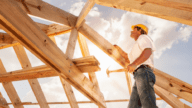Buying New Construction for the First Time? Here Are the Dos and Don’ts You’ll Need to Know Before Jumping In
- Published on
- 15 min read
-
 Allison Bethell, Contributing AuthorClose
Allison Bethell, Contributing AuthorClose Allison Bethell Contributing Author
Allison Bethell Contributing AuthorAllison Bethell is a writer, real estate investor, broker, small business owner, and consultant and has a B.A. from Villanova University in Sociology and Business. She has over 15 years of real estate experience, including flipping properties, selling houses, property management, luxury condominium development, as well as marketing and recruiting for large real estate brokerages. She has been featured in articles by outlets such as Forbes, The New York Times, The Street, and Realtor Magazine.
-
 Jedda Fernandez, Associate EditorClose
Jedda Fernandez, Associate EditorClose Jedda Fernandez Associate Editor
Jedda Fernandez Associate EditorJedda Fernandez is an associate editor for HomeLight's Resource Centers with more than five years of editorial experience in the real estate industry.
The journey to homeownership is such an exciting time in your life. You’re looking at new construction as an option for your new home and love the idea of buying a brand-new house that has never been lived in before.
You will be the first person to cook in the kitchen, relax in the tub, and host get-togethers in the backyard. However, you want to arm yourself with the tools and insider information so you don’t get too carried away with the new build. We’re going to equip you with the top dos and don’ts of buying new construction.
The dos of buying new construction
Keep the following steps in mind when purchasing a new construction home:
1. Decide on the type of new construction you want
Once you’ve decided that you want to purchase a new construction home, it’s time to determine what kind of new build you are looking for. What fits into your budget, and how much time do you have to devote to the process? Here are three types of new construction homes to consider: Custom, semi-custom, and spec homes.
Custom homes are exactly as they sound…customized to your needs! These are typically one-of-a-kind homes and tend to be more expensive than spec or semi-custom homes. You will start by purchasing a plot of land and then hiring a team to plan and complete the project from start to finish.
These homes take the most amount of time to build because you need to hire each person on the team including an architect, general contractor, and a variety of sub-contractors. This is a time-consuming process and you will need to give your input on everything from the floor plan to the bathroom tiles.
Finding a plot of land to purchase for your custom home can also be difficult, and you will want to take your time to decide on where you could see yourself living. You may want to be up in the mountains overlooking an alpine lake, or purchase an oceanfront lot so you can hear the waves gently crashing every morning.
Semi-custom homes give you some flexibility and choice but you’re not putting in as much time and effort as you would with custom homes. You’re choosing from pre-set finishes, and you may get to choose paint colors, types of flooring, fixture finishes, and appliance packages.
You will also be able to choose upgrades for certain items if you want to add some luxury features. For example, instead of the standard travertine tile floors in the entryway, you may be able to upgrade to marble tiles if you are willing to pay extra (or negotiate).
Spec homes, also referred to as production homes, are homes that are built without any particular buyer in mind. These allow you to choose a few paint colors and add-ons, but you will mostly get pre-built features that the builder has already decided on.
These homes will have shorter timelines, less customization options, and will be almost move-in ready. This can be a great option for buyers who want to purchase a new home but aren’t looking to spend the time customizing (and waiting on) their new home.
2. Research and vet your preferred builders
Once you decide on the type of new construction home you want to purchase, you need to research potential builders. You can check out online review sites, builder websites, and drive by other homes they have built in the area.
Other places to find out more about different builders include builder open houses and home shows. Local mortgage lenders, title companies, real estate attorneys, and real estate agents will also be able to give you a list of their preferred builders.
If possible, try to get in touch with homeowners who live in a home built by a builder you are interested in to get their thoughts on how the process was and how the house is holding up. The National Association of Home Builders suggests asking questions such as: Are you happy with your home? If you had any problems, were they fixed promptly and properly? Would you buy another home from this builder?
3. Research the neighborhood and surrounding areas
Pay attention to your commute time, access to local amenities, and potential natural disaster zones when researching neighborhoods. Do a trial drive from the neighborhood to your work or other places you frequent to see what the commute is like.
Check out neighborhood events, festivals, and community organizations to learn more about the area and the people who live there. It could also help to make a list of amenities that are important to you and see if these places are nearby. You may want to be able to walk to a coffee shop, a supermarket, or a dog park, or may want a short drive to a biking trail or local restaurants.
4. Work with a buyer’s agent that specializes in new construction
You may be wondering if you need a real estate agent to help you buy a new construction home, and the answer is a resounding yes! A good buyer’s agent will be able to help you throughout the entire process, including searching for homes, setting up builder appointments, making an offer, scheduling inspections, and reviewing the builder’s timeline. They will also help to explain contracts and accompany you to closing.
Even if the builder has agents working for them or representatives, we still recommend hiring an agent to represent you and your best interests. Remember, the builder’s agents represent the best interests of the builder and their bottom line, not yours.
HomeLight’s agent matching tool can help you find a top local real estate agent with experience in new construction, so you can let them do most of the hard work that buying a new build requires.
5. Consider your lot choices and choose wisely
Check out a variety of lots, if available, and notice the differences. Do you want to have neighbors on both sides of you? Do you like the idea of living in a cul-de-sac? Do you want a larger lot and neighbors only on one side?
Ask the builder questions about land boundaries, parking, construction timelines for neighboring houses, and anything that may be built in the future that could potentially obstruct your view.
You don’t want to choose a specific lot because of the gorgeous ocean view, only to realize that a year from now, not only will you be surrounded by construction noise and debris, but your view will also be blocked by a condo building.
6. Look at a variety of floor plans
If the builder offers different floor plans, check them all out and take your time choosing one that meets your needs. Decide which plan will work best for both your current situation and the future.
If you’re planning on living in the house for a long time, will you want to walk up a flight of stairs multiple times each day in your older years? Do the bedrooms offer enough privacy? Would three levels be too much of a challenge with a newborn and a toddler?
Also, check out features like closet location and space, number of bathrooms, and the size of the rooms you will be spending the most time in. Asking yourself the tough questions during this stage can save you a lot of headaches later on when your needs may change.
7. Tour the model homes
Builders usually have model homes, and some even have virtual model homes that you can tour to get a feel for different styles and floor plans. It can be helpful to see a floor plan in person to understand the flow of the space and determine what you like and don’t like. These models can also give you different ideas on how to furnish your new home and let you see for yourself what the storage situation is like.
However, keep in mind that you’re not buying the model home. These are often used to sell you on using that particular builder and will have a lot of upgrades, immaculate staging, and might not reflect what your finished product will be.
8. Shop around for your mortgage
The builder may have a preferred lender that they work with or may even offer in-house financing, but it’s always best to shop around and compare loan types, interest rates, terms, and closing costs. Start with the bank or credit union that you already use and see if they offer mortgages. They might offer a good deal because you already have a banking relationship with them.
But don’t stop there! More options are always better when it comes to getting a mortgage loan, and you won’t see an effect on your credit score until you officially apply for the loan. If you go with the first lender that approves you for a loan, then you could be missing out on a significantly better deal for you, financially speaking.
Once you get prequalified or preapproved for a mortgage with a few different lenders, then you can compare the loans offered with the builder’s lender and see which has the best financing for your needs.
Keep in mind that each lender will have different qualification requirements, such as a minimum credit score, debt-to-income ratio, proof of income, and employment history.
9. Negotiate with the builder
Many buyers have a misconception that new construction homes have set prices, and you won’t be able to negotiate with your builder. This just isn’t true — you can negotiate on the price of the lot, upgrades, appliance packages, warranties, and financing. In fact, you should be negotiating every step of the way.
Your agent will be your best advocate in getting you the best price and the most upgrades. It’s important to feel comfortable with your home purchase and know that you got the best bang for your buck, so don’t be shy in negotiations.
10. Tour the house during the construction phase
You should tour the house several times during the construction phase, if possible. This way, you will be able to track the progress and have any mistakes corrected before it is too late. Keep your eye on upgrades that were added to your contract, such as a second kitchen island or additional outlets in the bathroom, and make sure you are getting what you requested.
The construction phase is also the best time to get anything extra installed that you may want. It may cost you a little more, but it’s much easier to install speaker wiring, automated window coverings, and security cameras at this stage rather than after the drywall is up.
Be sure, however, to coordinate all visits with the builder to make sure it is safe to visit the property. Building sites can be extremely dangerous if you’re not careful, and your contractor will want to plan ahead to avoid injury.
11. Pay close attention to warranty timelines
When buying any new home, there are implied warranties, express warranties, and manufacturer’s warranties to keep track of.
Implied warranties
An implied warranty is typically more vaguely worded, has a 10-year liability cutoff period for builders, and covers potential defects in workmanship that may impact a new home’s safety and habitability, based on local building codes. According to Dickinson Wright, in Arizona, implied warranties will be upheld in court, even if it isn’t explicitly stated in the builder contract. This is done to hold the builder responsible for building a home fit for habitation and free from defects.
Express warranties
Some builders also offer an express warranty, which has more precise wording describing what exactly is covered and for how long. Different systems in your new home (like your electrical system or plumbing) might be covered for different periods of time, so make sure to read the fine print to keep track of when you can register a complaint or have an issue fixed.
Manufacturer warranties
A manufacturer warranty is offered by the manufacturer of the product and these are commonly used for appliances. For example, Samsung may offer a warranty on their washing machines and dryers, but it will only be honored for a specified number of years and won’t apply if the machines are visually damaged.
When in doubt, consult with a real estate agent or real estate attorney to go over the warranties and clarify anything you don’t understand.
12. Plan to paint and add fixtures
Unless you specified otherwise, paint colors will most likely be neutral and fixtures will be builder grade. You may be able to paint that beautiful turquoise accent wall yourself, but you should probably hire a professional to put up wallpaper or paint a custom mural in the nursery.
Planning ahead to paint and install any special fixtures, such as window coverings and lighting, before move-in can help save you time later on as you won’t have to cover your furniture or move anything out of the house.
That crystal chandelier you had your eye on at the fancy antique store downtown may look amazing in your dining room, but remember to budget for it and its installation.
The don’ts of buying new construction
1. Don’t choose the first builder you find
Don’t make a rushed decision and choose the first builder that you come across. They may end up being the builder you go with in the end, but at least do your research first.
Compare them with other builders in the area. Ask around about their reputation and what to expect when working with them. You don’t want to blindly choose a builder because you fell in love with a property and then realize down the road that they have a lot of complaints against them or are known to be difficult to work with.
2. Don’t be afraid to ask questions
As the saying goes, no question is a stupid question. There’s nothing to be scared about. This is your future house, and your hard-earned money at stake. Ask away!
Builder contracts can be very complicated, and you could end up missing vital information if you aren’t familiar with the process. For example, you may not realize that some appliances aren’t included with the home, or the kitchen cabinets you wanted are considered an upgrade and are costing you more than you can spend. These kinds of scenarios can be avoided if you get the clarity you need upfront.
Working with a skilled real estate agent will be instrumental to getting all of your questions answered, as they will know exactly what to ask the builder and can act as a liaison.
3. Don’t forget to document defaults and get them fixed
When you’re completing your final walkthrough of your new house, document everything that needs to be fixed in as much detail as possible. Be sure to take photos of everything that you see and work with your real estate agent to communicate each request to your builder. It’s better to be overly diligent than lackadaisical during this process.
Make sure that the builder fixes all of the necessary repairs and defaults before you move in. If you allow the builder to promise to make repairs after closing, you won’t know if or when they will get done, your moving schedule will be interrupted by contractors, and you might need to clean up after them.
4. Don’t forget to read the fine print of what is and what isn’t included
When you’re signing a contract to purchase your new construction home, it’s important to know exactly what you’re getting and for what price. Read all documents from your builder in their entirety before signing, and once again, consult with your real estate agent and/or attorney if you have any questions or concerns.
Pay special attention to which appliances are and are not included, what comes standard with the house, and what is considered an upgrade. Keeping track of the items that you will need to purchase yourself, such as a refrigerator, window treatments, light fixtures, and security cameras, will help you keep your budget on track and prepare you for moving in.
5. Don’t go overboard on the upgrades
It can be easy to get carried away with builder-offered upgrades, but you will have major sticker shock when your $400,000 new construction home suddenly turns into a $650,000 home because you upgraded everything.
Check out the upgrades that are offered and decide what is most important to you. Consider what will add value to the home and what will meaningfully enhance your experience, and stick to those upgrades.
You don’t necessarily need the fanciest fixtures, a steam shower, and a heated toilet seat in your guest bathroom that is rarely used. That extra money could go toward upgrading your appliances if you love to cook, or upgrading your flooring in higher-traffic areas.
Over-customizing can make the house more comfortable for you in the short term, but it could make resale more difficult in the long term. Everyone has different tastes, so keep that in mind before splurging on an item that is very taste-specific.
Stick to a budget you can afford. You don’t want to over-extend yourself at this stage because you will need to account for the costs of moving and furnishing your new home. Going leaner with the upgrades can save you some serious room in your budget later on for things like furniture, artwork, and landscaping.
6. Don’t count on the timeline to go exactly as planned
According to Brad Gore, who works with 74% more single-family homes than the average agent in Branson, Missouri, you should add 30 to 60 days to the builder’s timeline just to be on the safe side. Otherwise, you may end up selling your current home before your new home is ready. This can mean moving items into storage and finding temporary housing until your house is completed, which is both inconvenient and expensive.
Delays are unfortunately common in new builds, so be sure to have a plan for when building takes longer than anticipated. Factor in supply chain issues, delays with labor and materials, as well as the time it takes for permits to be approved.
7. Don’t think your home will look just like the model
When you walk through the model home, it’s easy to get swept away by the staging and fancy countertops and imagine that your home will look just like it. However, that’s not always the case.
Model homes are usually outfitted with all of the upgrades that the builder offers to entice you to buy them. Take this into account and remember that not all of these upgrades are worth the added expense.
Instead, try to focus on the floor plan when touring the model home to make sure it will meet your needs. For example, look at the closets, bedroom sizes, and overall layout — will you have enough storage for your whole family’s belongings?
8. Don’t skip inspections
Inspections are still incredibly important in new home builds to check for shoddy workmanship. Be sure to hire a licensed home inspector to test the functionality of all systems in your new home.
Your inspector should be testing the HVAC system, plumbing, appliances, electrical system, and more. They will also make sure that there are no tripping hazards, water leaks, or mold growth. You should always attend inspections and ask questions if you are concerned about anything you see.
9. Don’t forget to budget for items not included with the home
Don’t forget to budget for the following things that are not usually included with a new construction home:
- Appliances not included in the contract
- Small appliances such as a blender, juicer, and coffee maker
- Window treatments
- Security system
- Indoor and outdoor furniture
- Home decor
- Mattresses
- Electronics such as televisions and speakers
- Area rugs
- Sprinkler system
- Additional landscaping such as flower beds or an herb garden
Bottom line
There are so many things to get excited about during the new construction home buying process — from choosing the exact washer and dryer you want, to deciding how to decorate.
Be sure to account for construction delays, read all the fine print, stick to your budget, and don’t skip any inspections. Then, remember to enjoy the process, and in no time, you will be unlocking your front door for the first time and starting the next chapter of your life.
Header Image Source: (ThomasPhoto / Shutterstock)






